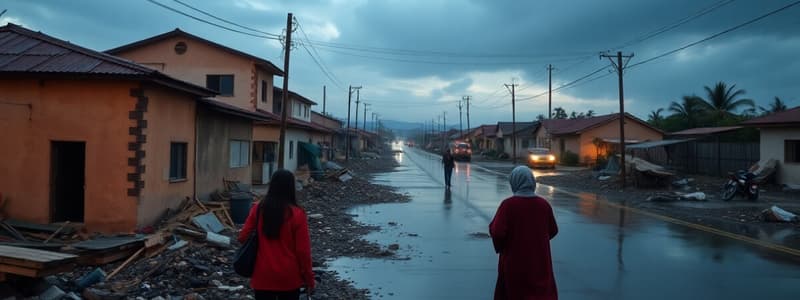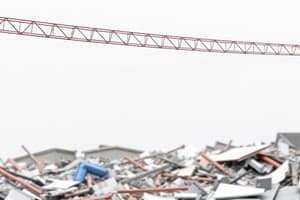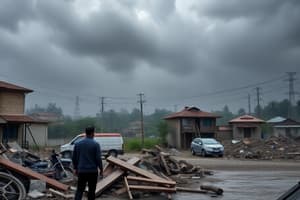Podcast
Questions and Answers
Which of these best defines a 'disaster', in the context of the text?
Which of these best defines a 'disaster', in the context of the text?
- Any large-scale calamitous occurrence that leads to destruction and affects the lives and property of at least 100 people.
- An event causing minor inconveniences that can be resolved by those affected.
- A temporary setback of normal societal function due to natural causes such as an earthquake or volcanic eruption.
- A significant disruption to a community or society, overwhelming its resources and causing widespread losses. (correct)
What is a key characteristic of locations within the Ring of Fire, as described in the text?
What is a key characteristic of locations within the Ring of Fire, as described in the text?
- The area is completely free from the threat of natural disasters.
- Locations experience a high concentration of seismic activity and volcanic eruptions. (correct)
- The ring is characterized by calm, stable geological conditions.
- The region is known for an unusually low frequency of natural disasters.
Which of the following is NOT considered a direct consequence of disasters?
Which of the following is NOT considered a direct consequence of disasters?
- Improved social cohesion after the incident and increased resources leading to accelerated economic growth. (correct)
- Loss of life and injury including disease and negative effects on physical, mental, and social well-being.
- Damage to properties, destruction of assets, and loss of essential services.
- Social and economic disruptions, environmental degradation.
Which of these options represents a disaster caused by human actions?
Which of these options represents a disaster caused by human actions?
According to the content, what increases the vulnerability of a region to industrial disasters?
According to the content, what increases the vulnerability of a region to industrial disasters?
Which of the following best describes the primary outcome of a complex emergency?
Which of the following best describes the primary outcome of a complex emergency?
What is the critical factor that differentiates a 'hazard' from 'disaster risk'?
What is the critical factor that differentiates a 'hazard' from 'disaster risk'?
In the context of disaster risk, what does 'vulnerability' primarily refer to?
In the context of disaster risk, what does 'vulnerability' primarily refer to?
What is the best definition for disaster risk?
What is the best definition for disaster risk?
Which of the following best identifies a factor that contributes to disaster risk related to human activity?
Which of the following best identifies a factor that contributes to disaster risk related to human activity?
Flashcards
Exposure
Exposure
The elements at risk from a natural or man-made hazard event.
Disaster Risk
Disaster Risk
The potential (not actual and realized) disaster losses, in lives, health status, livelihoods, assets, and services.
Vulnerability
Vulnerability
The inability of a community to resist the impact of a hazard.
Coping Capacity
Coping Capacity
Signup and view all the flashcards
Disaster Risk Factors
Disaster Risk Factors
Signup and view all the flashcards
Disaster
Disaster
Signup and view all the flashcards
Ring of Fire
Ring of Fire
Signup and view all the flashcards
Natural Disaster
Natural Disaster
Signup and view all the flashcards
Man-Made Disaster
Man-Made Disaster
Signup and view all the flashcards
Disaster Definition
Disaster Definition
Signup and view all the flashcards
Study Notes
Disaster Readiness and Risk Reduction
- Disaster is a sudden, calamitous occurrence causing great harm, injury, destruction, and devastation to life and property.
- Disasters affect two elements: life (human or animal) and property.
- Disaster effects range from minor damage (broken windows, doors) to major damage (torn rooftops, collapsed walls) and total destruction (destroyed houses and structures), and death.
- A disaster is a serious disruption of a community or society involving widespread human, material, economic or environmental losses exceeding the affected community's ability to cope with its own resources.
- Disasters result from exposure to hazard, conditions of vulnerability, and insufficient capacity or measures to reduce or cope with potential negative consequences.
- Disaster impacts include loss of life, injury, disease, damage to properties, destruction of assets, loss of services, social and economic disruptions, and environmental degradation.
- Disasters are classified into natural and man-made.
- Natural disasters are caused by natural forces and can be rapid onset or progressive. Examples: earthquakes, typhoons, volcanic eruptions, hurricanes, fires, tornadoes, extreme temperatures (drought).
- Man-made disasters are caused by intentional or non-intentional human actions. Examples: technological/industrial disasters (unregulated industrialization, inadequate safety standards), terrorism/violence (bombs, explosions), complex humanitarian emergencies (conflicts or wars, genocide).
Risk Factors Underlying Disaster
-
Exposure: Presence of people, property, or resources in areas potentially adversely affected by a disaster. Examples: coastal villages exposed to storm surges and tsunamis, croplands near rivers exposed to floods. Severity from high (first-hand victims) to moderate (rescue workers) to low (indirect observers).
-
Vulnerability: Degree to which a system, community or individual is susceptible to and unable to cope with adverse effects of a disaster considering social, economic, physical, and environmental conditions. Examples: low-income family with a poorly built wooden house, limited disaster awareness and emergency services.
-
Hazard: Potentially damaging physical events or human activities. Examples: earthquakes, volcanic eruptions, typhoons.
How to Reduce Effects of Disaster
- Hazard Identification: Identifying the specific hazards your family might face.
- Resilience: Building resilience by improving preparedness and developing response plans.
- Equipping: Equipping communities with resources and knowledge to mitigate risks.
- Steps to reduce disaster effects: Check hazards at home, identify safe places, educate family, have disaster kits, develop emergency communication plan, help community get ready, and practice the disaster preparedness cycle.
Additional Considerations
- Gender and family
- Age
- Economic status
- Climate Change
- Environmental Degradation
- Globalized Economic Development
- Poverty and Inequality
- Poor Urban Development
- Weak Governance
Disaster Risk
- Disaster risk is the potential (not actual) disaster losses in lives, livelihoods, assets, and services. This is a product of possible damage caused by hazards due to vulnerabilities within the community. It is situation-specific and hazard-specific.
- Factors that increase vulnerability include high population density, limited capacity for disaster risk reduction.
Disaster Mitigation
- Disaster mitigation measures aim to eliminate or reduce the impacts and risks of hazards before emergencies.
Elements at Risk
- Physical elements: urban land use, building types, building costs, essential facilities (shelters, schools, hospitals).
- Socio-economic: population density, economic activities.
- Environmental elements: ecosystems, protected areas, natural parks, wetlands.
Project 1: Information Brochure
- Project tasks include observing a community, determining exposed elements, and differentiating vulnerabilities to specific hazards.
- The project involves creating a tri-fold information brochure on disaster risks and relevant risk reduction measures.
Hazard, Type, Impact, Identification and Risk Assessment
- Types of hazards: natural (earthquakes, tsunamis), quasi-natural (pollution, smog), technological (chemical spills).
- Hazard identification is the process of determining physical and nonphysical agents in a workplace.
- Risk assessment involves prioritizing hazards considering probability and severity. Key steps are identifying hazards, assessing risks, making changes, and checking changes.
- Steps in risk assessment: Identify hazards, assess risks, make changes, and check changes. Risk assessment tables may be helpful.
Different Impacts of Hazards
- Physical impact: including injuries, destruction of infrastructure, wide spread destruction of housing.
- Psychological impact: including grief, psychological illnesses, marital conflicts, depression.
- Socio-cultural impact: including displacement, loss of cultural identity, forced adoption of new cultures, ethnic conflicts.
- Economic impact: including loss of jobs, loss of harvest, loss of farms, loss of money.
- Environmental impact: including loss of forests, loss of water, disturbance of biodiversity, loss of natural rivers
- Biological impact: including epidemics to people and flora/fauna, proliferation of viral diseases.
What's New: 1 Pic, 1 Word
- These are word puzzles where you have to arrange jumbled letters based on the image.
Studying That Suits You
Use AI to generate personalized quizzes and flashcards to suit your learning preferences.




